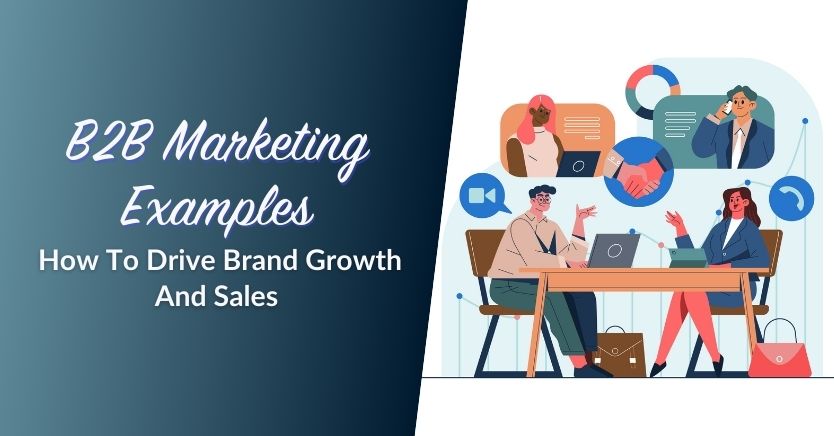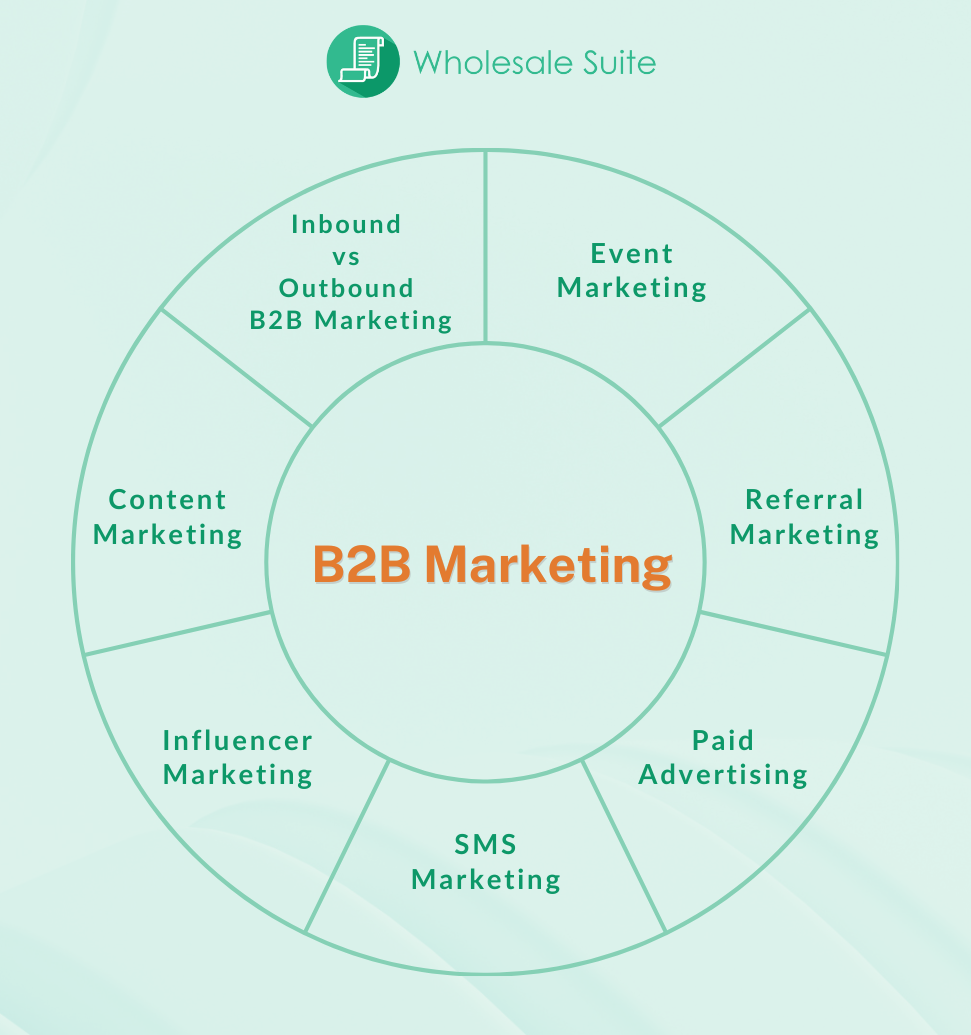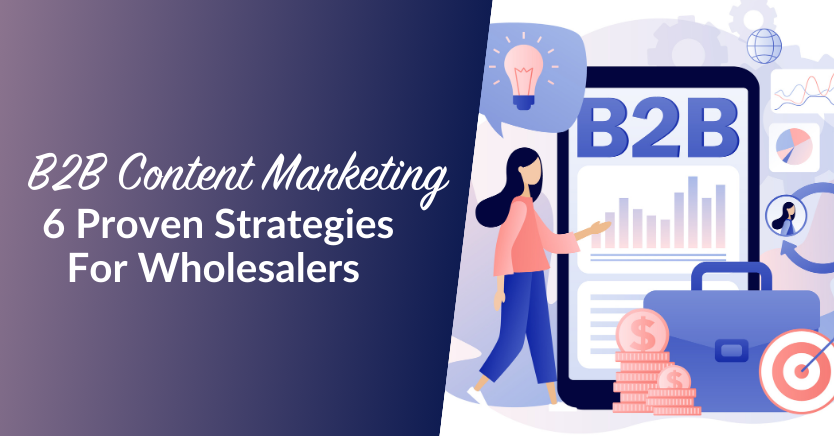
Businesses need the right marketing strategies to stand out, especially in the B2B space. Although simply put, B2B (business-to-business) marketing focuses on selling to other businesses. But what are the best ways to do that? That’s exactly what we’ll cover in this article! We’ll explore B2B marketing examples and strategies that will help businesses drive growth and sales.
Ready to learn more? Let’s dive in!
What Is B2B Marketing?
B2B marketing, or business-to-business marketing, refers to strategies companies use to promote their products or services to other businesses. Instead of targeting individual customers, B2B marketing focuses on organizations that need solutions to improve their operations, increase efficiency, or scale their business. Think of companies that sell software, wholesale goods, or industrial equipment—these businesses use B2B marketing to reach their ideal customers.
B2B marketers rely on specialized tools to streamline their workflows and enhance decision-making. One essential category is product management tools, which help teams plan, track, and optimize product strategies efficiently.
Unlike B2C marketing, where emotional appeal plays a big role, B2B marketing is more logical and value-driven. Buyers in the B2B space make decisions based on return on investment (ROI), efficiency, and long-term benefits. That’s why content marketing, email marketing, and digital marketing strategies are essential in this field. But before we discuss what these things are, let’s explore the different types of B2B marketing businesses that are most commonly used today.
Understanding your product target market is essential in B2B marketing to effectively tailor messaging and solutions to the unique needs of each business segment.
Types Of B2B Marketing
1. Inbound vs outbound B2B marketing
To make you understand the difference between these two, let’s just put it simply this way: inbound marketing focuses on attracting customers through content, SEO, and organic reach, while outbound marketing involves actively reaching out to potential clients through cold emails, ads, or calls.
For example, a business using inbound marketing might create valuable blog posts, videos, and social media content to naturally draw customers in. Meanwhile, outbound marketing would involve directly reaching out to potential clients through paid advertisements, direct mail, or cold calling to generate interest.
2. Event marketing
This type of B2B marketing pertains to a strategy wherein companies host trade shows, networking events, and webinars to introduce their products or services. Imagine a manufacturer of eco-friendly packaging attending a business expo to showcase its latest biodegradable materials. This allows them to demonstrate product effectiveness, answer client questions in real-time, and build industry connections.
3. Content marketing
This involves creating blogs, guides, and infographics to educate potential customers. For instance, a company selling accounting software might create a tutorial or step-by-step articles on financial management best practices. This positions them as a knowledgeable authority by making their software a more attractive solution.
Read more about content marketing here: B2B Content Marketing: 6 Proven Strategies For Wholesalers.
Here are several other ways that content marketing can be involved:
- Blog content marketing – Businesses publish informative articles on their website to establish credibility. These articles can help potential clients understand industry challenges while showcasing the company’s expertise.
- Social media marketing – Companies use social platforms to engage with their audience, share insights, and promote products. A marketing agency, for instance, might share helpful tips on Instagram or LinkedIn about improving digital advertising campaigns. This strategy keeps them top of mind for businesses seeking marketing solutions.
- Video marketing – Businesses create explainer videos, how-to guides, and testimonials to engage their audience. Videos like these help potential clients visualize how the product works, which makes it easier to convert them into customers.
- Podcasting – Some businesses use podcasts to discuss industry trends and share expertise. This builds credibility and attracts professionals seeking knowledge in that space.
- Email marketing – Companies send newsletters, promotional emails, and follow-ups to nurture leads. For instance, a company or business might send an email series introducing new features to existing users while offering exclusive discounts for upgrades. This keeps customers engaged and encourages conversions.
4. Referral marketing
This type of B2B marketing encourages satisfied customers to recommend a business to others. A wholesale supplier, for example, could offer discounts to B2B buyers who refer new clients. This strategy helps generate leads while rewarding loyal customers.
5. Influencer marketing
Businesses collaborate with industry experts to expand their reach. A project management software company might partner with business consultants to review and recommend its platform. This can drive trust and credibility among potential buyers.
6. SMS marketing
Companies send targeted text messages for promotions, reminders, and updates. It is a direct communication strategy that helps businesses engage customers, drive sales, and build relationships with a more personal touch.
Bonus Tip: Tactics like SMS and email marketing work best when used with clear, measurable goals. These direct channels are highly effective ways to increase ecommerce sales, especially when paired with timely offers or personalized product suggestions.
7. Paid advertising
Businesses invest in Google Ads, LinkedIn Ads, and Facebook Ads to attract leads. This strategy is particularly effective because it allows businesses to target specific audiences based on factors like location, demographics, interests, job titles, and online behavior.
B2B Marketing Examples
1. HubSpot’s content marketing strategy
By offering valuable, informative content, HubSpot establishes itself as an industry expert while generating leads. According to a report by HubSpot (2024), companies that use content marketing generate 67% more leads compared to those that do not.
Their blog receives millions of monthly visitors, demonstrating how high-quality content can drive B2B success. Their extensive library of eBooks, webinars, and online courses helps nurture leads and convert them into paying customers.
2. LinkedIn’s social media approach
LinkedIn is not only a professional networking site but also a prime example of B2B social media marketing. The platform uses targeted advertising, thought leadership articles, and professional networking features to attract businesses looking for talent, partnerships, and brand growth. Their sponsored content and LinkedIn Ads help companies reach decision-makers effectively.
According to DC Insights (2024), 80% of B2B leads come from LinkedIn, proving its effectiveness as a lead-generation tool.
Businesses that use LinkedIn for organic engagement and paid advertisements often see higher conversion rates than those using traditional social media channels.
3. Salesforce’s event marketing success
Salesforce is well known for event marketing, especially through its annual Dreamforce conference. This massive event gathers industry leaders, partners, and potential customers to experience Salesforce’s latest innovations. Dreamforce attracts over 170,000 attendees annually, making it one of the largest B2B marketing events in the world.
According to Decision Foundry (2024), companies that participate in events like Dreamforce report a 35% increase in customer engagement and 25% higher lead conversion rates.
Hosting webinars and conferences allows businesses to engage directly with potential clients, showcase expertise, and build long-term relationships with partners and customers.
4. Mailchimp’s email marketing campaigns
Mailchimp excels in email marketing, using automation and personalized campaigns to nurture leads and retain customers. By segmenting their audience and sending tailored messages, Mailchimp ensures that businesses receive relevant promotions and product updates, increasing engagement rates significantly.
Email marketing remains one of the highest ROI marketing strategies, generating $42 for every $1 spent. Companies that implement Mailchimp’s email automation tools often experience a 30% increase in open rates and 20% higher click-through rates, which proves the effectiveness of personalized email communication.
5. IBM’s influencer marketing strategy
IBM has successfully leveraged influencer marketing by collaborating with industry thought leaders and professionals. A study by Edelman found that 63% of B2B buyers trust influencer recommendations over traditional advertising. Through blog collaborations, video interviews, and research publications, IBM positions itself as a trusted expert, making its B2B technology solutions more appealing.
IBM’s partnerships with industry leaders allow it to enhance credibility, improve brand awareness, and connect with businesses that rely on expert insights for purchasing decisions.
Strategies And Tips From These B2B Marketing Examples
1. Invest in high-quality content marketing
Content is king in the world of B2B marketing. As mentioned in our B2B marketing examples, a strong content marketing strategy helps businesses attract leads, educate potential customers, and establish authority. Companies should create detailed blog posts, whitepapers, case studies, and video content that offer real value.
2. Maximize the power of social media marketing
Social media isn’t just for B2C brands—it’s essential for B2B success too! Some B2B marketing examples for platforms like LinkedIn, Twitter, and Facebook allow businesses to engage with industry professionals, share insights, and promote their products. Furthermore, posting case studies, hosting Q&A sessions, and interacting with comments all contribute to building trust and increasing brand awareness.
3. Use email marketing to nurture leads
Email marketing remains one of the most cost-effective and high-converting B2B marketing strategies. As mentioned in our B2B marketing examples above, you’d be able to conclude that businesses that use personalized email sequences, follow-ups, and newsletters have a high chance of keeping potential clients engaged. Effective email marketing campaigns often include targeted messaging, automated workflows, and lead segmentation to enhance engagement and conversion rates.
4. Host engaging virtual events
Hosting webinars, live Q&A sessions, and virtual conferences is a great way to build trust and authority in the B2B field. In our B2B marketing examples insights, virtual events allow businesses to showcase their expertise, interact directly with potential clients, and demonstrate their products in real-time.
Unlike physical events, which require significant investments in travel, venue booking, and logistics, virtual events eliminate geographical barriers and make it easier for businesses to reach a global audience. Many B2B marketing examples showcase how companies use webinars, live Q&A sessions, and virtual conferences to engage with a broader audience while reducing costs.
Attendees can join from anywhere in the globe. Moreover, recorded versions of these events can be repurposed into on-demand content, blog posts, and video snippets, extending their marketing impact long after the live session ends.
5. Leverage referral marketing for business growth
Happy customers are the best advocates for your business. Offering incentives to clients who refer others can significantly boost B2B sales. Many businesses that follow these B2B marketing examples demonstrate how offering incentives to clients who refer others can significantly boost B2B sales. Encouraging satisfied customers to share their experiences helps businesses expand their network and acquire new clients without large marketing expenses.
Frequently Asked Questions
What is the difference between B2B and B2C marketing?
B2B marketing focuses on selling products or services to other businesses, whereas B2C marketing is geared toward individual consumers. The sales cycle in B2B is also much longer, involving multiple decision-makers, negotiations, and contracts, whereas B2C purchases are typically quicker and more straightforward.
How can you use the B2B customer journey to improve marketing efforts?
The B2B customer journey involves multiple stages. At the awareness stage, businesses should focus on informational content like blog posts, whitepapers, and industry reports to educate potential customers. During the consideration stage, case studies, webinars, and comparison guides help prospects evaluate different solutions. At the decision stage, providing free trials, personalized demos, and consultations can help convert leads into customers. By aligning marketing efforts with the customer journey, businesses can build strong relationships, nurture leads, and improve conversion rates.
What are the 4 types of B2B you can market to?
B2B markets can be categorized into four main types. Producers manufacture goods or provide services essential for other businesses, such as raw materials for production. Resellers purchase products in bulk and sell them for profit. Governments require goods and services for public projects. Lastly, Institutions, such as schools and hospitals, prioritize cost-effectiveness and long-term partnerships when selecting vendors. Each of these markets demands unique sales approaches, pricing structures, and marketing techniques to effectively engage potential clients and drive long-term success.
Which social media platform is best for B2B marketing?
LinkedIn is the most effective social media platform for B2B marketing because it provides access to decision-makers, industry leaders, and professionals actively seeking business solutions. Companies use the platform to share thought leadership content, post industry insights, and engage in networking and direct outreach. Additionally, LinkedIn Ads allow businesses to target specific job roles, industries, and company sizes, which ensures that your marketing efforts reach the right audience.
Takeaways
B2B marketing is crucial for businesses looking to grow and increase sales. By implementing B2B marketing campaign strategies, companies can reach the right audience and convert leads effectively.
In this article, we explored B2B marketing examples and strategies that will help businesses drive growth and sales:
- What is B2B marketing?
- Types of B2B marketing
- B2B marketing examples
- Strategies and tips from B2B marketing examples
Successful brands prove that the right marketing approach can drive massive success. Businesses can use various marketing channels to expand their reach, whether through digital marketing strategies, campaigns, or paid ads.
To succeed in B2B marketing, companies must stay updated with marketing trends, experiment with different tactics, and continuously refine their strategies to build trust with their audience.
Do you have questions about this article? Let us know in the comments!






